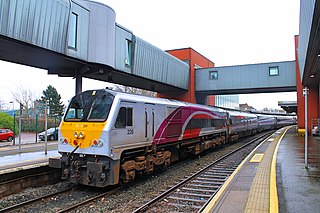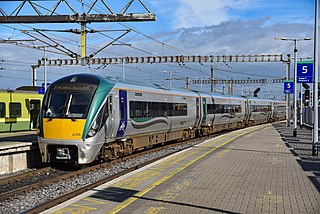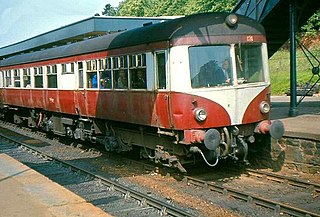
NI Railways, also known as Northern Ireland Railways, is the railway operator in Northern Ireland. NIR is a subsidiary of Translink, whose parent company is the Northern Ireland Transport Holding Company (NITHCo), and is one of eight publicly owned train operators in the United Kingdom, the others being Direct Rail Services, Northern Trains, Transport for Wales Rail, Southeastern, LNER, ScotRail, and TransPennine Express. It has a common Board of Management with the other two companies in the group, Ulsterbus and Metro.

Rail transport in Ireland is provided by Iarnród Éireann in the Republic of Ireland and by Northern Ireland Railways in Northern Ireland.

Iarnród Éireann, or Irish Rail, is the operator of the national railway network of Ireland. Established on 2 February 1987, it is a subsidiary of Córas Iompair Éireann (CIÉ). It operates all internal InterCity, Commuter, DART and freight railway services in the Republic of Ireland, and, jointly with Northern Ireland Railways, the Enterprise service between Dublin and Belfast. In 2019, IÉ carried a record peak of 50 million passengers, up from 48 million in 2018.

The Mark 2 family of railway carriages are British Rail's second design of carriages. They were built by British Rail workshops between 1964 and 1975 and were of steel construction.
Although prototype diesel locomotives ran in Britain before World War II, the railways of both the Republic and Northern Ireland changed over much more rapidly from steam to diesel traction than those in Britain, due to the island's limited coal reserves and an ageing steam locomotive fleet.

The Córas Iompair Éireann 201 Class was a class of 34 diesel electric locomotives manufactured by Metropolitan-Vickers at their Dukinfield Works in Manchester. They were a smaller, lighter and less powerful version of the 001 Class and were originally intended for branch line passenger and freight duties. They were introduced in 1956 and, although their duties changed over the years, were in regular service on the Irish railway network until the mid-1980s. Six were sold to Northern Ireland Railways (NIR) in 1986.

The 'NIR 101 Class ' is a class of diesel-electric locomotive formerly operated by Northern Ireland Railways (NIR). With the return to the working of the Enterprise service from Belfast to Dublin with coaching stock instead of augmented diesel railcar sets, NIR found itself with no suitable main line diesel locomotives. The 101 Class became the answer to the immediate problem working in conjunction with the newly acquired British Rail Mark 2 coaches.

The Iarnród Éireann (IÉ) / Northern Ireland Railways 201 Class locomotives are the newest and most powerful diesel locomotives operating in Ireland and were built between 1994 and 1995 by General Motors Diesel. They are model type JT42HCW, fitted with an EMD 12-710G3B engine of 3,200 hp (2,400 kW), weigh 108.862 tonnes and have a maximum speed of 164 km/h (102 mph).
A wide variety of hauled coaches have been used on the railways of Ireland. This page lists all those since 1945.

Enterprise is the cross-border inter-city train service between Dublin Connolly in the Republic of Ireland and Belfast Lanyon Place in Northern Ireland, jointly operated by Iarnród Éireann (IE) and NI Railways (NIR). It operates on the Belfast–Dublin railway line.
Push–pull is a configuration for locomotive-hauled trains, allowing them to be driven from either end of the train, whether having a locomotive at each end or not.

The 80 Class is a type of diesel electric multiple unit formerly used by Northern Ireland Railways. They were affectionately nicknamed 'Thumpers' by rail enthusiasts due to the thumping noise their engines produced.

InterCity is the brand name given to rail services operated by Iarnród Éireann that run between Dublin and other major cities in Ireland. InterCity branding is also used in other European countries by unaffiliated organizations.

The 22000 Class "InterCity Railcar" is a diesel multiple unit in service with Iarnród Éireann in Ireland.

The 2600 Class is a type of diesel multiple unit operated on the Irish railway network by Iarnród Éireann, used mainly for short-haul Commuter services. They sometimes operate Cork to Dublin services in case an InterCity unit is not available. At present the entire class is based in Cork, and is used on local services to Mallow, Midleton, Cobh and on token services to Tralee. A hybrid unit was based in Limerick until it was withdrawn in 2012 and is now stored in Cork.

The 450 Class is a type of diesel multiple unit (DMU) passenger train formerly used by Northern Ireland Railways. They were affectionately nicknamed 'Thumpers' and 'Castles' by rail enthusiasts.

The Class 4000 is a type of diesel multiple unit (DMU) in service with Northern Ireland Railways.

The Córas Iompair Éireann (CIÉ) 2600 Class were Associated Equipment Company (AEC)–engined diesel multiple units that operated InterCity and suburban services on the CIÉ system between 1952 and 1975. Many were later converted for push–pull operation with diesel locomotives, finally being withdrawn when displaced by the electric Dublin Area Rapid Transit service in the mid-1980s.

The Córas Iompair Éireann/Iarnród Éireann 071 Class or Northern Ireland Railways 110 Class or Serbian Railways JŽ series 666 is a General Motors Electro-Motive Division EMD JT22CW series diesel-electric locomotive used in the Republic of Ireland, Northern Ireland and Serbia.

The GNRI BUT Class was a fleet of diesel-powered railcars operated by the Great Northern Railway Board and its successors between 1957 and 1980. They were an evolution of the earlier AEC railcars, which had entered service in 1951.








































